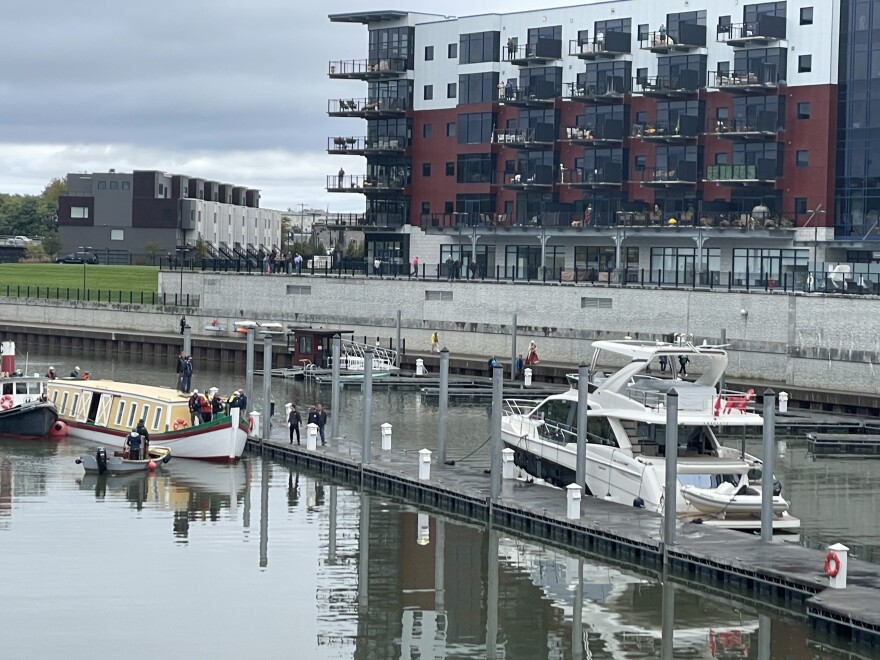Schenectady’s Mohawk Harbor welcomed the Seneca Chief, a full-scale replica of the original, which New York Governor DeWitt Clinton sailed on to inaugurate the Erie Canal in 1825, with the Erie Canal song performed by Niskayuna High School chorus students.
In 1825, Governor DeWitt Clinton marked the completion of the Erie Canal by traveling from Buffalo to New York City, which is the same journey its replica is making this month. The boat was built with the efforts of more than 200 volunteers from the Buffalo Maritime Center. The volunteers also serve as members of the crew at different stages of the Chief’s 33-day journey. The Seneca Chief will make 28 community stops on the way to New York Harbor.
The Chief was welcomed by several Schenectady elected officials Tuesday, including Mayor Gary McCarthy, New York State Assemblyman Angelo Santabarbara, County Legislature Chair Gary Hughes, and former Schenectady Mayor Brian Stratton, who all spoke at the event.
Assemblyman Santabarbara spoke about the influence of the Erie Canal on New York’s economy 200 years after its construction.
“200 years later, the Erie Canal continues to shape who we are. It connects more than 200 communities across New York State, supports 1000s of jobs, brings in more than 300 million in annual economic impact through recreation, tourism and transportation. And right here in Schenectady, we've seen the revitalizing our waterfront, this beautiful Mohawk Harbor.”
The development of Mohawk Harbor has been a long-running project for the city of Schenectady, in an effort to revitalize the area and build a business and tourism center in the area. What was once an abandoned industrial site now has a 100,000 square-foot arena, a casino, restaurants and apartment buildings.
County Legislature Chair Gary Hughes also spoke about the industrial economy that powered Schenectady’s growth.
“The legacy of the canal remains woven in to the fabric of Schenectady County's identity. From the early days of the Schenectady Locomotive Works – we stand on the grounds of that facility as we are here – to the founding of General Electric the canal quite literally fueled our growth, connected us to the world, and shaped the community that we are so proud to call home.”
Although the Erie Canal was instrumental in the economic growth of New York State, the construction of the canal also displaced Indigenous people from their homes. According to the land acknowledgment adopted by the Erie Canalway National Heritage Corridor Commission, the lands and waterways that make the Erie Canal were constructed on the ancestral homelands of the Haudenosaunee Confederacy and the Mohican Nation.
As part of the effort to recognize the impacts of the construction of the Erie Canal on Indigenous people in New York state, the crew of the Seneca Chief is planting an Eastern White Pine Tree in each of its stops. The tree is known as the Great Tree of Peace in Haudenosaunee culture. At the Seneca Chief’s final stop in New York Harbor, the last tree planted will be watered from a collection of sources gathered at each stop as part of a ceremonial “Gathering of the Waters.” This ceremony is a nod to Governor DeWitt Clinton’s “Wedding of the Waters” in 1825, when he poured a barrel of water from Lake Erie into the Atlantic.
Brian Trzeciak, the Executive Director of the Buffalo Maritime Center, spoke about the importance of acknowledging the displacement of Native Americans as a consequence of the building of the Erie Canal.
“We can say the Erie Canal was wonderful. It did a lot of things to create New York City, to create Buffalo, to bring immigration, to open up the doorway to the West. Those things are true. You could also say that because of that people were removed, that people had to be displaced. And what we are doing on this trip, as we are branching out that narrative, we're saying that you can tell the story from 1817, 1825, but you really should start a little bit back.”
John Montague, founder of the Buffalo Maritime Center, and member of the crew, told WAMC about the considerable effort that more than 200 volunteers put into the construction of the replica.
“We wanted to be built by the public, for the public and in the public. So that was a huge part of the challenge of getting this thing done. We built this boat with two professionals, two professional people from our staff and 220 volunteers for four years. They stuck with us for four years to build this boat.”
Montague also said that those four years’ worth of work has paid off, noting how the Seneca Chief has been welcomed at each of its stops.
“The response has been enormous, just over the top, I mean, way beyond anything [we imagined]. Little towns, the entire town shows up, or more people that even live in the town. People have said, I've never seen so many people in the town at one time, you know. So it's been very gratifying doing that.”



